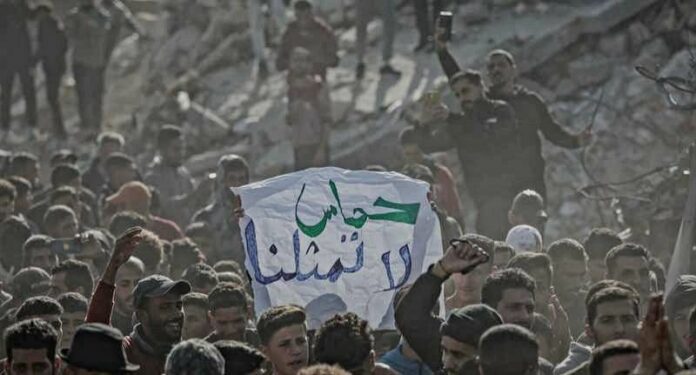By Mirna Fahmy
In Gaza, the incidents took a stern turn hearing the voices of the people of the strip who have been dealing with both Israeli rocket strikes and Hamas attacks for over a year.
On March 25, 2025, protests erupted in Gaza as thousands of Palestinians marched into the streets of Beit Lahia, expressing frustration with Hamas, marking a rare public display of dissent against the militant group. The protests came following the Israeli Defence Forces (IDF) warning to the people in the town urging them to evacuate as they detected an attack base for Hamas that fires rockets towards Israel.
Widespread anger over the prolonged conflict with Israel, which has caused significant devastation and loss of life in Gaza, drove the demonstrations. Protesters chanted slogans such as “Hamas out”, “Our children’s blood is not cheap” and “We refuse to die,” demanding an end to the war and criticising Hamas for its role in perpetuating the violence.
Protesters have also chanted at Al Jazeera for their refusal to cover the unprecedented opposition to Hamas. After the 17 months of bloodshed, the people were chanting, “The people do not want war; the people do not want Hamas.”
The crowds have flooded into the streets of Khan Younis and Rafah, not against Israel, but against Hamas. One man told AFP: “If Hamas leaving power is the solution, why don’t they do it to protect the people?”
In another shared video that has the watermark “the channel of activist Hamza al-Masry”, an old man was saying, “We are the people of peace; we demand peace for this strip and no ruling with iron and fire.”
Armed Hamas militants reportedly beat and dispersed protesters, according to the videos that are widely shared via Palestinians who have been fighting to convey what’s in reality, acting as citizen journalists. Some protesters were evacuated, but some resisted by throwing stones.
The Assembly of Southern Gaza Clans has called for an uprising against Hamas (Intifada), accusing it of risking Palestinian lives for its own interests.” The assembly has even issued a powerful call for a popular uprising—the “Friday of Rage”—against Hamas, set for Friday, March 28, 2025 between 1 PM and 6 PM. According to Palestinians, demonstrations are expected to take place in the following locations: Jabalia, northern Gaza, Deir al-Balah Camp, Nuseirat. 4- Gaza City (Rimal), Khan Younis (Jasser Building and Bani Suhaila Roundabout), Al-Shuja’iya (Al-Mawqif), Beit Lahia, and northern Gaza. The day passed and there was no confirmation or videos of how these protests went by.
University professors in Gaza have as well issued a statement expressing their support for the protests in Gaza and the people’s right to express their opinions freely.
Quds News Network reported Hamas’ strongly worded statement on Thursday March, 27, 2025 against the protesters, holding them responsible for the occupation’s withdrawal from negotiations with them. They threatened to treat the protesters in a traitor manner.
On March 24, 2025, Hamas said that Egypt floated a proposal for a Gaza truce—free five hostages, including the last American, in exchange for aid and a weeklong pause.
Israel responded that it hasn’t even seen the plan and is sticking to the U.S.-backed Witkoff framework, which Hamas already blew off. Officials warn that if Hamas doesn’t fold soon, Israel’s next step is a full-scale ground campaign.
Israel is even planning to put Gaza under its rule. The Israeli Minister of Defence, Israel Katz, issued a warning to the residents of Gaza after hearing their protest against Hamas: “The IDF will soon operate with full force in additional areas of Gaza, and you will be asked to evacuate from combat zones for your own safety.
Hamas is putting your lives at risk, causing you to lose your homes and more and more territory that will be integrated into Israel’s defence formation.”
Referring to Hamas as “the second Sinwar,” he continued: “they sit safely with their families in tunnels or luxury hotels, with billions in foreign bank accounts—while using you as hostages.”
Katz urged all Gazans to “learn from the residents of Beit Lahia to demand the removal of Hamas from Gaza and the immediate release of all Israeli hostages—this is the only way to stop the war.”
Since Israel resumed its military campaign in Gaza on March 18, 2025, nearly 700-1000 Palestinians have been killed, with at least 673 fatalities reported by March 23, 2025. This adds to the total death toll of over 50,000 Palestinians since the conflict began in October 2023.
Saudi-Lebanese cleric and current Secretary-General of the Arab Islamic Council, Mohamad Ali El Husseini, has pinpointed a future spotlight on the fate of Palestine on his X account on March 23, 2025: “No Jewish official will ever be granted the right to establish an independent Palestinian state. Any Jewish official who does so will meet the same fate as Israeli Prime Minister Rabin – murder at the hands of the Jews – and will be considered a traitor to the doctrine of Greater Israel.”
El Husseini added that the forced displacement of the people of Gaza and the West Bank will proceed and be implemented, no matter the cost, and anyone who opposes or attempts to prevent it will pay the price.” He warns, “We do not believe that anyone will stand in the face of the Greater Israel Storm, lest they be crushed—or more accurately, chopped up.”
The fate of Palestinians of Gaza:
The Israeli newspaper Haartez reported that Israel voted to establish a bureau for Gazans’ “voluntary emigration” to “facilitate passage to third countries,” though none have agreed to accept them.
However, no third country has publicly agreed to accept large numbers of refugees, raising concerns about the feasibility and ethical implications of the plan.
Critics argue that the initiative could amount to forced displacement or ethnic cleansing, particularly given the ongoing conflict and humanitarian crisis in Gaza since the aggression resumed.
In an official response, Egypt strongly condemned Israel’s plan to establish an agency for Palestinian displacement from Gaza and the approval of 13 new West Bank settlements. It rejects Israel’s claim of “voluntary departure,” stressing that forced displacement under bombardment, starvation, and blocked aid constitutes a violation of international law. Egypt urges the international community and the UN Security Council to take decisive action to uphold Palestinian rights, including self-determination and statehood based on the June 4, 1967 borders, with East Jerusalem as the capital.
The move aligns with proposals by the U.S. President Donald Trump, who suggested relocating Gaza’s population to develop the territory into a tourist destination.
The Hebrew Channel 12 News, has reported that approximately 100 Palestinians from Gaza are set to travel to Indonesia for employment in the construction sector as part of a voluntary migration pilot program.
While international law allows those who leave Gaza for work to return, the broader objective is to facilitate long-term migration, contingent on Indonesia’s cooperation. This marks the first time such a program has been implemented involving Indonesia as a destination for Palestinian workers.
In the West Bank, videos and testimonies by Palestinians showed dozens of masked Israeli settlers- storming the Palestinian village of Jinba in Masafer Yatta, attacking homes and injuring five residents— including a 15-year-old child now in critical condition.
What is Hamas?
After these protests, perspective on Hamas has been diverted. Hamas is originally known as a “Palestinian Resistance Movement” that fights the occupying force which is Israel. The U.S. National Counterterrorism Center (NCTC), under the Director of National Intelligence (DNI), has designated Hamas as a terrorist organization depending on the perspective and context, as established by the Intelligence Reform and Terrorism Prevention Act of 2004 (IRTPA).
Founded in 1987 during the first Palestinian intifada, Hamas emerged from the Palestinian branch of the Muslim Brotherhood and operates primarily in the Gaza Strip and parts of the West Bank. Its charter initially called for the establishment of an Islamic Palestinian state in place of Israel and rejected agreements between the Palestine Liberation Organization (PLO) and Israel.
Hamas has a robust sociopolitical structure and won legislative elections in 2006, becoming a significant political force in the Palestinian territories. It has governed the Gaza Strip since 2007, after ousting the Palestinian Authority, and has engaged in political activities, including participating in elections and governing the region.
Hamas’s military wing, the Izz al-Din al-Qassam Brigades which is considered by DEI a terrorist organization, has conducted numerous attacks against Israel, including suicide bombings, rocket attacks, and kidnappings. These actions have led to its designation as a terrorist organization by multiple countries, including the United States, the European Union, Canada, and Australia.
The group’s tactics include targeting both military and civilian populations, which has resulted in significant casualties and has been a major point of contention in the Israeli-Palestinian conflict.
Hamas’s ideology distinguishes itself from other Palestinian groups, such as PLO, through its Islamist foundation and its emphasis on jihad (holy struggle) as a central tenet.
Gaza’s dire consequences
Hamas has never succeeded in destroying Israel. Its attacks, including the October 7, 2023, assault, have caused significant casualties and destruction but have not come close to achieving its stated goal of eliminating the Israeli state. The October 7 attack, which killed over 1,195 Israelis and took 251 hostages, was one of the deadliest in Israel’s history but did not threaten its existence.
Regarding Gaza, Hamas has not directly destroyed Gaza itself, but its actions have led to devastating Israeli military responses that have left the territory in ruins. Since Hamas took control of Gaza in 2007, there have been four major conflicts (2008–09, 2012, 2014, and 2021), each resulting in extensive destruction and requiring reconstruction.
The most recent war, which began in October 2023, has been particularly catastrophic, with over 50,000 Palestinians killed and significant infrastructure damage, including the destruction of approximately 370,000 housing units, 79,000 of which were completely destroyed.
Hamas has been known to store weapons and operate from densely populated areas, effectively using civilians as shields, according to New York Times. For example, tunnels have been constructed under civilian infrastructure, such as homes and hospitals, which endangers non-combatants during military engagements. The Al-Monitor report highlights that Hamas leaders and militants are familiar with routes to security tunnels, which are often located under civilian buildings, further implicating the use of human shields.
After the Israeli ground operation in Gaza, Reuters team were permitted to enter and document how the tunnels are built and the direction of their exits.


